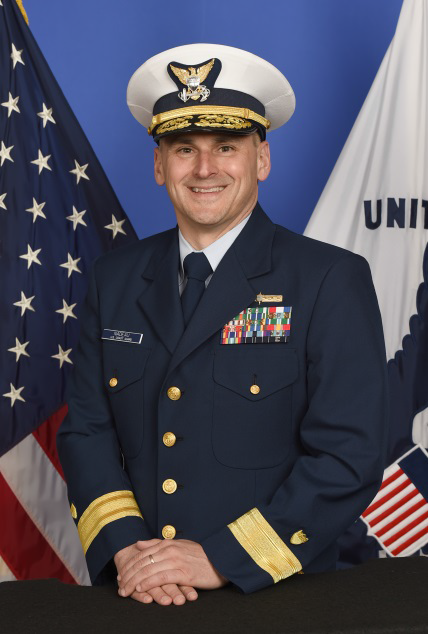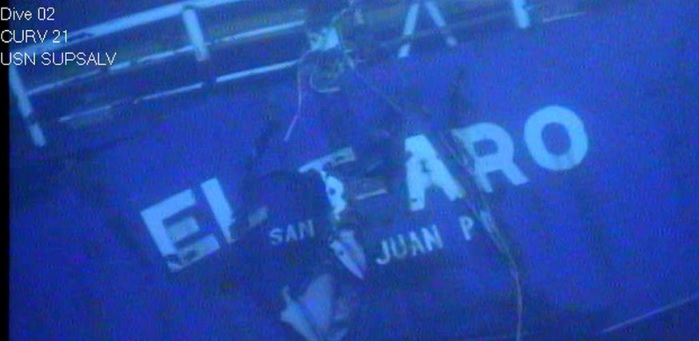In the aftermath of El Faro casualty, Rear Admiral John P. Nadeau, Assistant Commandant for Prevention Policy, US Coast Guard, highlights that the adoption of a proactive safety culture, remains the number one priority. Lessons learned from this tragedy shed light to the importance of incorporating contingency planning into SMS, including also heavy weather conditions. RADM Nadeau provides an overview of the investigation, highlighting key aspects of voyage planning and operations for enhanced safety at sea.
SAFETY4SEA: What safety challenges did the El Faro accident unveil in promoting a safer operating environment onboard? What needs to be done further from both operators’ side and USCG’s response?
RADM Nadeau: The loss of the El Faro and all 33 persons aboard was a tragic and preventable accident. While the primary cause of the casualty was the decision to navigate in close proximity to a Category 3 hurricane, there were other contributing factors. These include:
- the failure of operating company to maintain an effective safety management system;
- the failure of the Recognized Organization to uncover or otherwise resolve longstanding deficiencies that adversely affected the safety and seaworthiness; and
- the failure of the USCG to properly oversee the work conducted by the Recognized Organization on our behalf.
The investigation noted numerous failures on the part of the operating company to properly fulfill its obligations under the ISM Code. Most relevant to this casualty was the company’s failure to provide the necessary shoreside support for the master to perform his duties safely. The overriding authority of the master does not absolve a company of its obligation under the ISM Code to provide such support. The findings also showed that the USCG failed to adequately oversee the Recognized Organization. As the lead agency of the U.S. Flag Administration, the USCG is ultimately responsible to monitor the performance of Recognized Organizations that perform delegated functions on U.S. flag vessels.
S4S: Which were the challenges during El Faro’s accident investigation? Are there any differences in the recommendations suggested by USCG and NTSB?
RADM Nadeau: The USCG Marine Board of Investigation (MBI) and NTSB worked closely together to gather and share all evidence, then each agency conducted its own analysis, developed independent conclusions, and authored separate reports. Although specific recommendations between the USCG MBI and NTSB may vary, the goal of both investigations was to determine the causal factors and make safety recommendations so that a tragedy of this magnitude never happens again. The USCG MBI and NTSB found many similar conclusions regarding the underlying systemic challenges in the safety framework. Locating the sunken vessel in 15,000 feet of water and the subsequent recovery of the voyage data recorder presented unique technical challenges. The NTSB and US Navy demonstrated amazing capabilities that enabled recovery of the VDR, which greatly improved the understanding of the timeline, decisions, and conditions onboard the vessel when the tragedy occurred.
Always ensure your officers and crew have the most current and accurate weather information available.
S4S: In the aftermath of the accident, what are your thoughts regarding effective leadership onboard and ashore in an emergency situations? How can the industry do the extra mile and cultivate strong safety culture in order to prevent similar incidents in the future?
RADM Nadeau: I believe the role of the regulator is to ensure that the operator has systems in place to optimize safety performance. However, regulatory compliance, by itself, is not sufficient to create and sustain a healthy safety culture. Each company and operator is different and must determine what their unique safety culture needs and what behaviors are critical to sustain such a culture. Simply adopting generic checklists and placing some general “off the shelf” SMS manuals in the master’s office is not enough. Senior leadership must be engaged and create an environment where safety culture can thrive. Constant focus on productivity or expenses, rather than safety performance, sends a message that safety is less important, too expensive, or someone else’s responsibility and simply achieved by minimum compliance with prescriptive regulations. A robust safety culture permeates all element of the entire company and must flow from the very top to the bottom – from the boardroom and shoreside management, all the way down to the port engineers, vessel master and the most junior crewmembers.
S4S: Given that El Faro’s USCG investigation brought light to several challenges in the industry’s safety framework, how is the accident expected to be a catalyst for change?
RADM Nadeau: This is a call to action for the entire maritime community. The El Faro casualty was the result of poor seamanship compounded by a failure of the safety framework that should have triggered a series of corrective actions that likely would have prevented it. We all can, and must, learn from this tragedy. Seafarers, supporting shoreside personnel, operating companies, Recognized Organizations, and flag states must act with a sense of urgency to ensure a robust, effective safety framework. We should all honestly assess our own safety management and oversight responsibilities and ask ourselves if we’ve truly adopted a safety mindset and seek continuous improvement, or if we’re simply doing the minimum necessary to maintain compliance.
S4S: Do you plan any changes/ improvements in USCG’s organization/ procedures/ policies/ training following the lessons learned from El Faro accident?
RADM Nadeau: As stated by the Commandant of the USCG in the Final Action Memo, we must, and will, improve our oversight of Recognized Organizations – those organizations that we entrust to act on our behalf. We are making changes to insure better visibility of RO decisions and improve our processes to track RO performance. We are modifying our organizational structure at Headquarters, revising our policy, creating new processes, and improving training with an emphasis on auditing skills. Third parties are fundamental to the current safety framework and provide outstanding capabilities. But as the Flag Administration and final element in the safety net, the USCG must maintain adequate oversight of all delegated functions, including those Safety Management System verification functions that are conducted on our behalf by our ROs.
The El Faro casualty was the result of poor seamanship compounded by a failure of the safety framework that should have triggered a series of corrective actions.
S4S: Considering the USCG safety recommendations with respect to El Faro accident, should we expect any regulatory updates or best practice developments in the near future?
RADM Nadeau: The Coast Guard is working with Congress, industry, and Federal partners on regulatory, legislative, and non-regulatory solutions to address the safety recommendations related to high water alarms, periodic dead weight surveys, and marine weather forecasting.
S4S: What are your suggestions to industry stakeholders to enhance the safety of operations onboard in case of heavy weather conditions? How could we prevent similar incidents in the future?
RADM Nadeau: First and foremost, no matter where you are in your organization, adopt and promote a proactive safety culture. Incorporate contingency planning and exercises, to include those associated with heavy weather conditions, into your safety management system. Ensure everyone ashore and aboard the vessel understands their authorities and responsibilities during an emergency, as well as the capabilities and limitations of the vessel, its machinery, and lifesaving equipment. Today, instantaneous availability of real-time information, coupled with reliable worldwide communications capability, give shoreside management the ability to support key aspects of voyage planning and operations. Ensure your officers and crew have the most current and accurate weather information available and know how, and when, to engage the designated person ashore. Finally, ensure all lifesaving and emergency equipment on board is in good repair and functioning properly.
About Rear Admiral John P. Nadeau, Assistant Commandant for Prevention Policy, U.S. Coast Guard
 Rear Admiral John Nadeau assumed the duties as the Assistant Commandant for Prevention Policy in July of 2017. In this capacity, he leads development of national policy, standards, and programs to promote Marine Safety, Security and Environmental Stewardship. He oversees three Directorates: Inspections and Compliance, Marine Transportation Systems, and Commercial Regulations and Standards. The programs under his leadership include waterways management, navigation and boating safety, ports and facilities, merchant mariner credentialing, vessel documentation, marine casualty investigation, commercial vessel inspections, and port state control.
Rear Admiral John Nadeau assumed the duties as the Assistant Commandant for Prevention Policy in July of 2017. In this capacity, he leads development of national policy, standards, and programs to promote Marine Safety, Security and Environmental Stewardship. He oversees three Directorates: Inspections and Compliance, Marine Transportation Systems, and Commercial Regulations and Standards. The programs under his leadership include waterways management, navigation and boating safety, ports and facilities, merchant mariner credentialing, vessel documentation, marine casualty investigation, commercial vessel inspections, and port state control.
His previous flag officer assignment was the Assistant Commandant for Capability, where he was responsible for identifying and providing service-wide capabilities and developing standards for staffing, training, equipping, sustaining, maintaining, and employing forces to meet all U.S. Coast Guard mission requirements.
Other assignments include Commanding Officer of the Coast Guard Marine Safety Center; Commanding Officer of Marine Safety Unit Wilmington, North Carolina, where he served as the Captain of the Port, Federal On Scene Coordinator, and Officer in Charge, Marine Inspection; Chief of Inspections at Marine Safety Office Corpus Christi, Texas; Senior Investigating Officer at Activities Baltimore, Maryland; and Chief of the Office of Design and Engineering Standards at U.S. Coast Guard Headquarters.
A native of Saco, Maine, Rear Admiral Nadeau graduated from the U.S. Coast Guard Academy with a Bachelor of Science degree in Naval Architecture & Marine Engineering and obtained advanced degrees in Mechanical Engineering and Naval Architecture & Marine Engineering from the University of Michigan. He earned a Master of Arts degree in Homeland Security and Defense from the Naval Postgraduate School and is licensed as a Professional Engineer in Virginia.
His military awards include the Legion of Merit, Meritorious Service Medal, the Coast Guard Commendation Medal, the Coast Guard Achievement Medal, the Army Achievement Medal, and the Transportation 9/11 Medal.
The views presented hereabove are only those of the author and not necessarily those of SAFETY4SEA and are for information sharing and discussion purposes only.




























































